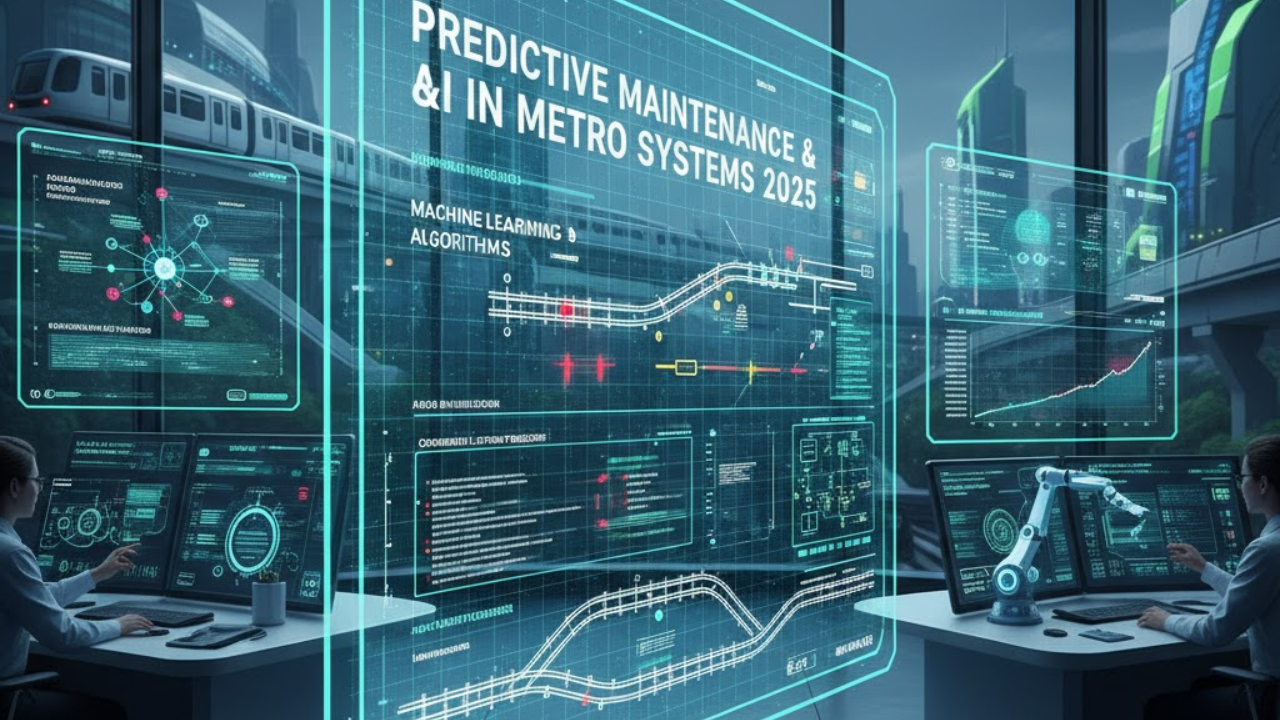
Post by : Meena Rani
Urban rail networks are the lifeline of modern cities — carrying millions of passengers daily through dense, fast-paced environments. But keeping these complex systems running smoothly is a huge challenge. That’s where Artificial Intelligence (AI) and Predictive Maintenance are stepping in to reshape how metros operate, reducing downtime, improving safety, and saving millions in maintenance costs.
In 2025, smart metros are no longer futuristic concepts. Cities like Singapore, London, Delhi, and Tokyo are already using AI-powered systems that monitor train health, predict failures before they happen, and optimize maintenance schedules in real time.
Predictive maintenance is a proactive approach that uses real-time data and AI algorithms to predict equipment failures before they occur. Instead of fixing a train or track component after it breaks down, sensors and data models help engineers detect anomalies early — enabling timely interventions and minimizing service disruptions.
In rail and metro systems, predictive maintenance typically monitors:
Wheel and axle vibrations
Brake system performance
Track wear and temperature
Signal reliability
Door mechanisms and HVAC systems
This shift from scheduled inspections to data-driven predictions allows operators to maintain higher service availability, improve passenger safety, and extend asset lifecycles.
AI doesn’t work in isolation. It relies on a network of technologies that bring data from the tracks to the cloud.
Thousands of IoT sensors are installed across trains, tracks, and signaling systems. These sensors continuously collect data such as temperature, vibration, voltage, and pressure — all indicators of machine health.
AI models process massive volumes of historical and live data to identify patterns invisible to the human eye. For example, a slight vibration change in a train’s bogie could signal early bearing wear — prompting maintenance before a breakdown occurs.
Modern metro operators are adopting AI-enabled platforms that integrate IoT, machine learning, and cloud analytics into a single dashboard. Engineers can remotely monitor fleet health and receive automatic alerts for potential issues.
Cities like Dubai and Hong Kong are already using such platforms to manage thousands of rail assets seamlessly.
The integration of AI in metro maintenance delivers measurable benefits that go far beyond cost reduction.
Reduced Downtime – Predictive models detect failures days or weeks in advance, allowing maintenance teams to fix issues without interrupting operations.
Lower Maintenance Costs – Preventing major failures reduces spare parts and labor costs by up to 30%.
Improved Passenger Experience – Fewer breakdowns and delays mean smoother, more reliable journeys for commuters.
Enhanced Safety – Real-time condition monitoring ensures critical systems are always within safety thresholds.
Longer Asset Life – Continuous data insights optimize asset usage, extending the life of trains, tracks, and infrastructure.
The London Underground uses AI-based data analytics to monitor escalator systems and detect performance deviations before mechanical failure.
The Delhi Metro Rail Corporation (DMRC) has integrated IoT and AI-based predictive tools that monitor rolling stock conditions and automatically generate maintenance schedules — boosting operational efficiency.
The Mass Transit Railway (MTR) has developed an AI-powered predictive maintenance platform analyzing more than 100,000 assets daily, drastically reducing unplanned service interruptions.
Singapore’s Land Transport Authority (LTA) deploys real-time AI diagnostic systems that use machine learning to detect abnormalities in traction power, signaling, and track circuits.
The next evolution of predictive maintenance goes beyond detection — it’s about self-diagnosing and self-repairing systems.
AI-driven robotics are now being developed to automatically inspect tracks, clean sensors, and even repair faults using 3D printing on-site.
Meanwhile, digital twins — virtual replicas of metro systems — are becoming standard for simulation, allowing operators to test maintenance strategies virtually before implementing them in the field.
With 5G connectivity, data from every sensor can now be transmitted with almost zero latency, enabling real-time decision-making at control centers.
According to MarketsandMarkets, the global AI in rail and metro systems market is projected to exceed $5.5 billion by 2030, growing at over 25% CAGR.
High-volume trending keywords in this sector include:
AI predictive maintenance, smart metro technology, digital rail transformation, IoT rail monitoring, AI in public transport, metro automation, real-time train analytics, smart railway infrastructure, AI operations 2025.
As cities push toward sustainable, efficient, and connected transportation systems, predictive maintenance powered by AI is becoming the backbone of modern urban mobility.
This article is for informational and educational purposes only. The content reflects recent trends and publicly available data in the transportation and technology sectors. It should not be considered professional advice for investment, engineering, or operational decisions.
AI in metro systems, predictive maintenance rail, smart metro technology, IoT in railways, metro digital transformation, real-time monitoring, AI rail analytics, railway automation, metro maintenance AI, smart transportation










Bengaluru-Mumbai Superfast Train Approved After 30-Year Wait
Railways approves new superfast train connecting Bengaluru and Mumbai, ending a 30-year demand, easi

Canada Post Workers Strike Halts Nationwide Mail and Parcel Services
Canada Post halts operations as CUPW strike disrupts mail and parcel delivery nationwide amid disput

PM Modi Launches BSNL ‘Swadeshi’ 4G Network, 97,500 Towers Built
India enters global telecom league as PM Modi inaugurates BSNL’s indigenous 4G, connecting 26,700 vi

India’s Iconic MiG‑21 Takes Final Flight After Six Decades of Service
After 60 years India retires its MiG‑21 fighter jet, a legendary yet controversial warplane marking

Hindustan Zinc unveils AI hotspot monitoring at Debari smelter
Hindustan Zinc launches AI-powered Switchyard Hotspot Monitoring at Debari smelter to cut outages bo

Chinese experts worked inside sanctioned Russian drone plant
Chinese drone specialists visited IEMZ Kupol supplying parts and drones via intermediaries, deepenin